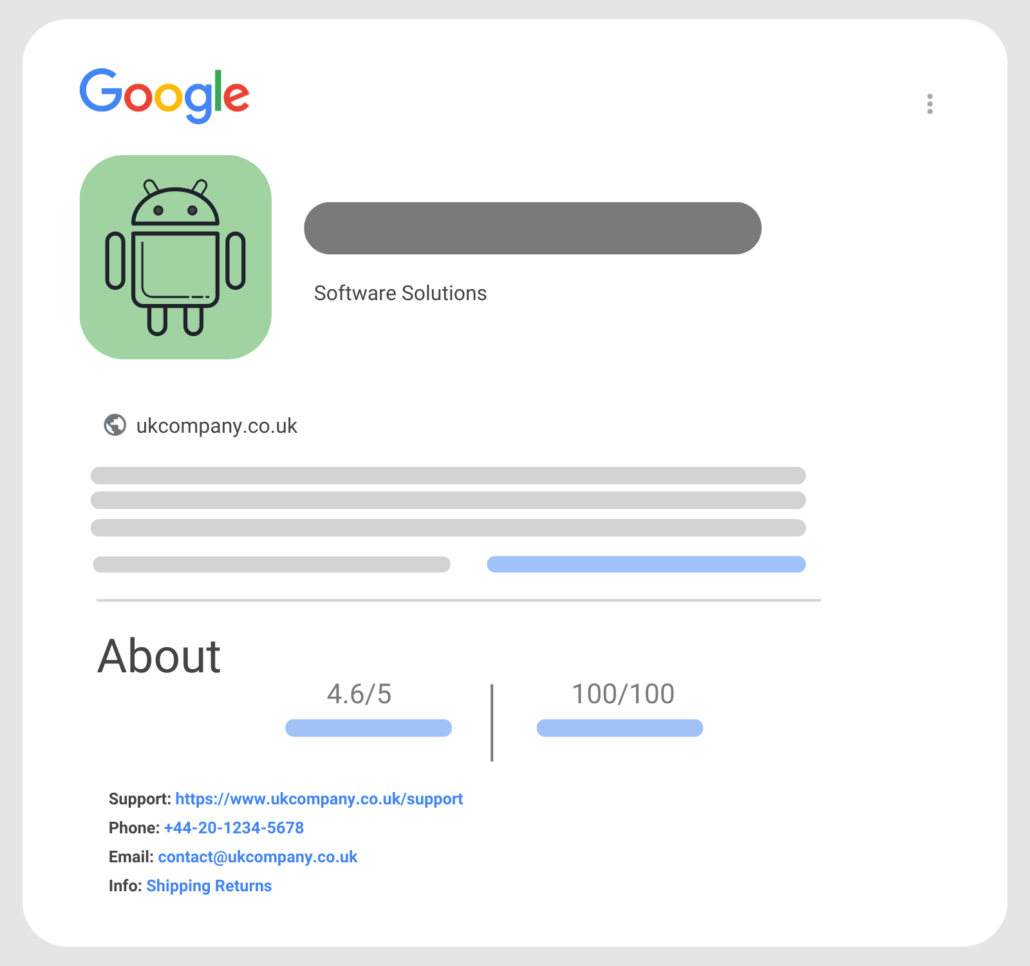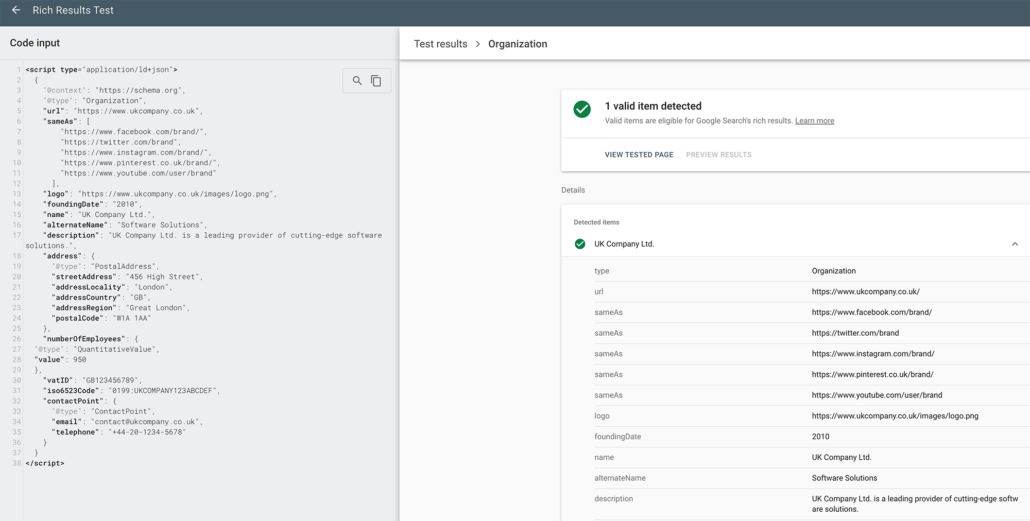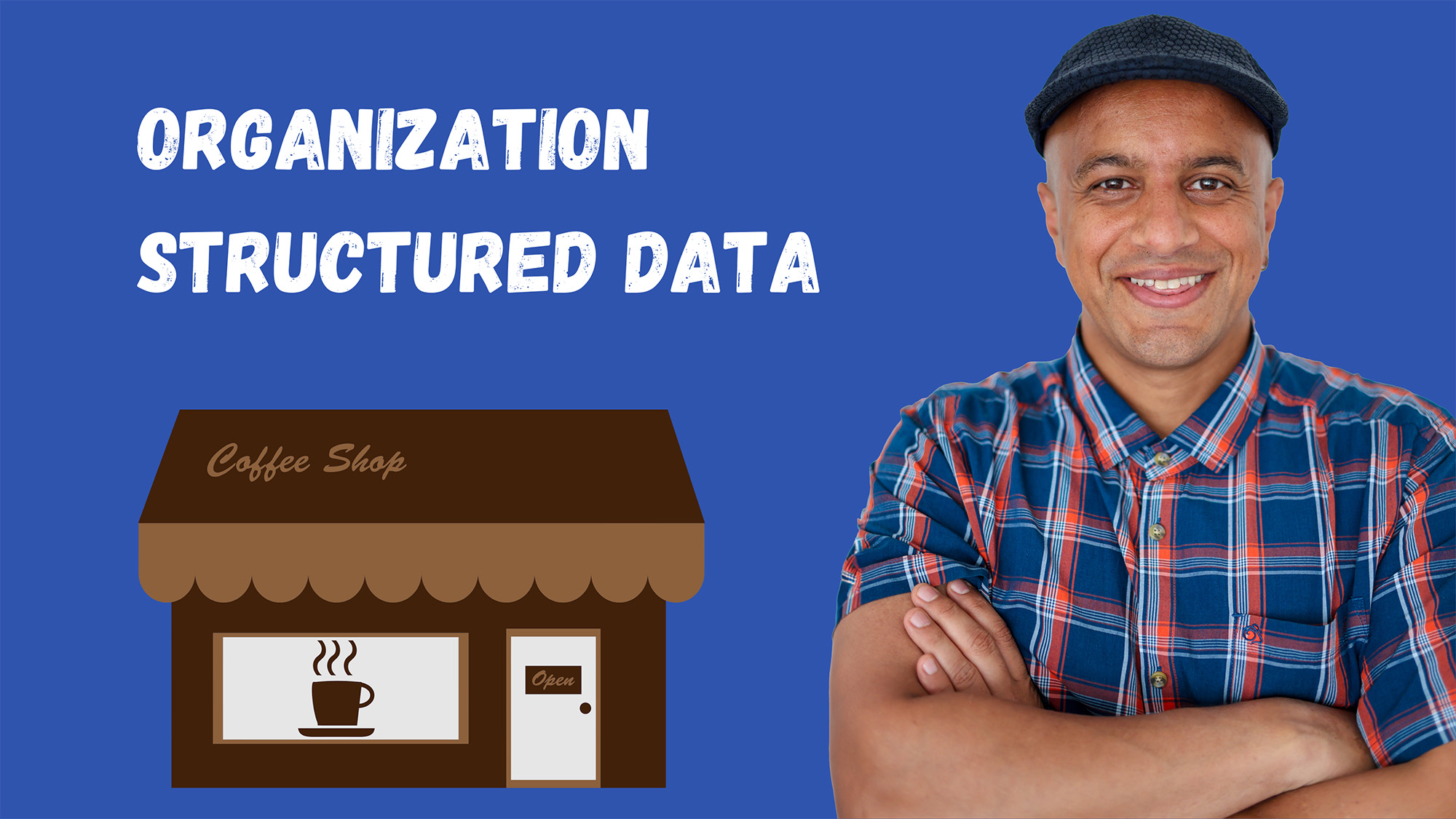In today’s digital age, establishing a strong online presence is crucial for businesses and organisations. One of the best ways to enhance the visibility of your company on Google is by implementing Organization Structured data on your website.
This structured data provides essential administrative details, such as logos, addresses, contact information, and business identifiers, to help Google accurately represent your organisation in knowledge panels and other visual elements.
In this article, I will delve into the importance of Organisation Structured data, the process of adding it to your website, and the recommended properties to maximise its effectiveness.
What is Organisation Structured Data?
Organisation structured data is a type of structured data that uses schema.org vocabulary to describe an organisation. Schema.org is a collaborative project that defines a set of standardised vocabularies for structured data.
The Organization schema.org type can be used to describe a wide variety of organisations, including businesses, non-profit organisations, and government agencies.
Why is Organization Structured Data Important?
Organization structured data is important for several reasons:
- Improved visibility in the SERPs: Search engines like Google use structured data to understand the content of a page and to provide more relevant and useful search results. By adding Organization Structured data to a website, an organisation can increase the chances that its website will appear in search results for relevant keywords thus positively impacting your SEO efforts.
- Enhanced knowledge panels: Knowledge panels are the boxes that appear to the right of search results for certain types of entities, such as people, places, and organisations. By adding Organization Structured data to a website, an organisation can increase the chances that its website will appear in a knowledge panel. Knowledge panels can provide users with a quick overview of an organisation, including its name, logo, website, and contact information.
- Increased user engagement: By providing users with more relevant and useful information about an organisation, organization structured data can help to increase user engagement. For example, if a user is searching for a specific product or service, organization structured data can help them find the right organisation and to contact them directly.

Organization Structured Data Example
<script type="application/ld+json">
{
"@context": "https://schema.org",
"@type": "Organization",
"url": "https://www.ukcompany.co.uk",
"sameAs": [
"https://www.facebook.com/brand/",
"https://twitter.com/brand",
"https://www.instagram.com/brand/",
"https://www.pinterest.co.uk/brand/",
"https://www.youtube.com/user/brand"
],
"image": "https://www.ukcompany.co.uk/example-image.jpg",
"logo": "https://www.ukcompany.co.uk/images/logo.png",
"foundingDate": "2010",
"name": "UK Company Ltd.",
"alternateName": "Software Solutions",
"description": "UK Company Ltd. is a leading provider of cutting-edge software solutions.",
"address": {
"@type": "PostalAddress",
"streetAddress": "456 High Street",
"addressLocality": "London",
"addressCountry": "GB",
"addressRegion": "Great London",
"postalCode": "W1A 1AA"
},
"numberOfEmployees": {
"@type": "QuantitativeValue",
"value": 950
},
"vatID": "GB123456789",
"iso6523Code": "0199:UKCOMPANY123ABCDEF",
"email": "[email protected]",
"telephone": "+44-20-1234-5678"
}
</script>How to Implement Organization Structured Data
There are no required properties for Organization Structured Data; instead, incorporate all the properties relevant to your organisation. I strongly recommend including the properties that are most useful to searchers, such as name, address, phone number, URL, and logo. Coincidentally, all these properties were included in the previous version of the organization’s structured data requirements.
Organization Structured Data Recommended properties
- name: The name of your organisation that you are also using for your site name (this is the name of the site that appears when Google shows a page in the SERPs).
- alternateName: Businesses commonly have related names, for instance, “Tesco Supermarkets” vs. “Tesco PLC.” The alternateName property marks up other well-known corporate name variations (including abbreviations), such as “Tesco”.
- legalName: Use this property to display the registered (legal name) of your organisation, in case it is different from the name property.
- description: Clearly describe your organisation. In my personal opinion this text should be very close to the text that you use in your meta description on your homepage, e.g. “UK Company Ltd. is a leading provider of cutting-edge software solutions”.
- logo: Use either a URL or ImageObject to link to the official logo of your organisation. The image should have a minimum size of 112px by 112px, the URL should be crawlable and indexable, and the image format should be BMP, GIF, JPEG, PNG, WebP, or SVG.
- url: The URL of your organisation. While using the main homepage URL is a common practice, the choice ultimately depends on your specific organisational structure and how you want to represent it in the structured data.
- sameAs: The URL of a page on another website containing supplementary information about your organisation. This could include a link to your organisation’s profile page on a social media or review site. With that in mind, you can provide Multiple sameAs URLs.
- address: Display the physical or mailing address of your organisation. If you have multiple addresses in different cities include them all in the code. This property relates to the schema PostalAddress property and is a required property if you are using a LocalBusiness type schema.
- address.streetAddress: Provide the full street address of your postal address.
- address.addressLocality: Provide the city of your postal address.
- address.addressRegion: Provide the region of your postal address, e.g. in the USA this would. be a state and in the UK this would be a county.
- address.postalCode: Provide the postcode of your address.
- address.addressCountry: Provide the country for your postal address using the two-letter ISO 3166-1 alpha-2 country code.
- contactPoint: Provide the best way your customers can contact your organisation.
- contactPoint.telephone: Provide the phone number your customers can use to contact you.
- contactPoint.email: Provide the email your customers can use to contact you.
- numberOfEmployees: Provide the number of employees by either using a specific number or a range.
- foundingDate: Using ISO 8601 date format provide the date your business was founded.
- iso6523Code: Provide the ISO 6523 code of your organisation separating the International Code Designator (ICD) and the identifier with a colon character (Recommended!).
- duns: Provide the Dun & Bradstreet D-U-N-S number of your organization. If you want to include the DUNS code, Google’s recommendation is to use the ISO 6523 code for your business and the DUNS code with a prefix, e.g., 0199:UKCOMPANY123ABCDEF.
- leiCode: Provide the Legal Entity Identifier (LEI) for your organisation. Similar to the duns property use the LEI in conjunction with the ISO 6523 code with a prefix.
- naics: Provide the North American Industry Classification System (NAICS) code of your organisation. Similar to the previous two properties use the naics in conjunction with the ISO 6523 code with a prefix.
- globalLocationNumber: Provide the Global Location Number (GLN) for your business, a unique identifier used to specify the location of a business or organization in the GS1 system.
- vatID: Provide the VAT (Value Added Tax) code of your organisation.
- taxID: provide the Tax / Fiscal ID associated with your company. The Tax ID must match the country that you have provided in the address property field.
Guidelines for Organization Structured Data
There are a number of guidelines that should be followed when adding organization structured data to a website. These guidelines are designed to ensure that the data is accurate, complete, and consistent.
- Accuracy: The data that is added to the organization’s structured data markup should be accurate and up-to-date.
- Completeness: All of the recommended properties for organization structured data should be added, if applicable.
- Consistency: The data that is added to the organization structured data should be consistent across all of the organization’s websites and other online properties.
The best page to place Organization Structured Data is the homepage or a page that describes your organization, such as an About Us page. You don’t need to include Organization Structured Data markup on every page of your website.
How to test your Organization Structured data markup
Once you have implemented Organization Structured data on your website, you can use Google’s Rich Results Testing Tool to test it. This tool will show you any errors or warnings in your markup.

FAQ
There are two main ways to add organization structured data to a website:
Using a plugin: There are several plugins available for popular content management systems (CMS) that can help to add organization structured data to a website. These plugins can be a good option for users who are not comfortable with coding.
Adding it manually: Organization structured data can be added to a website manually by adding a JSON-LD or Microdata snippet to the code of the page. This option is more complex than using a plugin, but it gives users more control over the data that is being added.
While JSON-LD (JavaScript Object Notation for Linked Data) schema can technically be placed anywhere on a webpage, it is recommended to include it in the <head> section of your HTML for clarity and readability (it separates metadata and structured data from the actual visible content of the webpage).
The <head> section is where you include meta information about your webpage, such as the title, character set, and other essential elements.
Google employs structured data to enrich its comprehension of web content, resulting in more informative and visually appealing search results. This structured format aids in generating rich snippets, refining the precision of voice search responses, integrating with the Knowledge Graph for contextual information, and ensuring a seamless experience across various devices. Through the implementation of structured data, businesses can optimise their online presence and deliver users more pertinent and engaging search results.


Leave a Reply